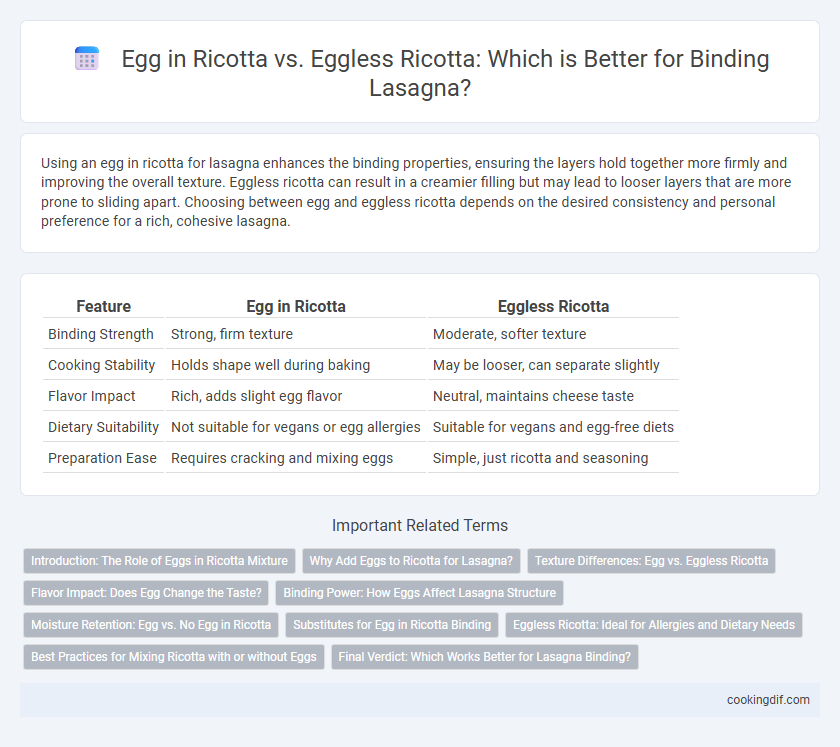Using an egg in ricotta for lasagna enhances the binding properties, ensuring the layers hold together more firmly and improving the overall texture. Eggless ricotta can result in a creamier filling but may lead to looser layers that are more prone to sliding apart. Choosing between egg and eggless ricotta depends on the desired consistency and personal preference for a rich, cohesive lasagna.
Table of Comparison
| Feature | Egg in Ricotta | Eggless Ricotta |
|---|---|---|
| Binding Strength | Strong, firm texture | Moderate, softer texture |
| Cooking Stability | Holds shape well during baking | May be looser, can separate slightly |
| Flavor Impact | Rich, adds slight egg flavor | Neutral, maintains cheese taste |
| Dietary Suitability | Not suitable for vegans or egg allergies | Suitable for vegans and egg-free diets |
| Preparation Ease | Requires cracking and mixing eggs | Simple, just ricotta and seasoning |
Introduction: The Role of Eggs in Ricotta Mixture
Eggs in ricotta mixtures provide essential binding properties that help maintain the structural integrity of lasagna layers during baking, resulting in a firmer, more cohesive texture. Eggless ricotta relies on alternative thickeners like cornstarch or extra cheese to achieve similar consistency but may produce a slightly softer, less stable filling. Choosing between egg and eggless ricotta depends on dietary preferences and desired texture, with eggs enhancing firmness and eggless options catering to vegetarian or allergy-friendly needs.
Why Add Eggs to Ricotta for Lasagna?
Adding eggs to ricotta for lasagna enhances the cheese's binding properties, ensuring the layers hold together firmly during baking and slicing. Eggs contribute protein and fat, which create a richer, creamier texture and prevent the ricotta from becoming watery. This binding effect improves the overall stability and structure of the lasagna, resulting in a more cohesive and visually appealing dish.
Texture Differences: Egg vs. Eggless Ricotta
Egg in ricotta cheese enhances the lasagna's texture by providing a firmer, more cohesive filling that holds its shape during baking. Eggless ricotta results in a softer, creamier consistency, which may lead to a looser filling that can spread more between pasta layers. The choice between egg and eggless ricotta significantly impacts the structural integrity and mouthfeel of the final dish.
Flavor Impact: Does Egg Change the Taste?
Egg in ricotta for lasagna enhances the texture by providing firmer binding, resulting in a creamier and richer mouthfeel. Eggless ricotta maintains a lighter, fresher flavor, preserving the natural tang of the cheese without adding extra richness. The presence of egg subtly deepens the overall taste profile, creating a more cohesive and savory filling.
Binding Power: How Eggs Affect Lasagna Structure
Eggs in ricotta provide superior binding power, creating a firmer and more cohesive lasagna structure by helping the cheese layer hold together during baking and slicing. Eggless ricotta results in a softer, creamier texture but may cause the layers to be less stable and more prone to spreading, impacting the overall firmness. The protein in eggs coagulates under heat, reinforcing the lasagna's structure and contributing to clean, well-defined slices.
Moisture Retention: Egg vs. No Egg in Ricotta
Egg in ricotta enhances moisture retention by acting as a natural binder, preventing the cheese mixture from becoming watery during baking. Eggless ricotta, while suitable for vegan or egg-free diets, tends to release more liquid, which can result in a less stable texture and increased sogginess in lasagna layers. Optimal moisture control is achieved by balancing ricotta's water content with either egg incorporation or careful straining methods.
Substitutes for Egg in Ricotta Binding
Egg in ricotta enhances lasagna's texture and firmness through protein binding, but eggless ricotta can be stabilized using alternatives like silken tofu, mashed potatoes, or cornstarch. These substitutes maintain moisture and improve consistency without altering the flavor profile, making the dish suitable for vegan or egg-free diets. Nutritionally, plant-based binders offer lower cholesterol and fat content while preserving the creamy consistency essential for rich lasagna layers.
Eggless Ricotta: Ideal for Allergies and Dietary Needs
Eggless ricotta serves as an excellent binding agent in lasagna recipes, especially for individuals with egg allergies or those following vegan or plant-based diets. This alternative maintains the creamy texture and moisture of traditional ricotta while ensuring the dish remains safe and suitable for various dietary restrictions. Using eggless ricotta enhances the versatility of lasagna, making it accessible to a broader audience without compromising flavor or consistency.
Best Practices for Mixing Ricotta with or without Eggs
In classic lasagna recipes, adding eggs to ricotta enhances binding, ensuring a firmer texture that holds layers together during baking. For eggless ricotta mixtures, incorporating thickening agents like Parmesan cheese or gently draining excess whey improves consistency without altering flavor. Optimal mixing involves folding ricotta gently to maintain creaminess while evenly distributing the binder for a balanced, cohesive filling.
Final Verdict: Which Works Better for Lasagna Binding?
Egg in ricotta enhances the texture and firmness of lasagna by providing a natural binder that helps the cheese layer hold its shape during baking. Eggless ricotta offers a lighter, creamier consistency but may result in a slightly softer, less structured filling. For optimal lasagna binding, ricotta mixed with egg delivers a more stable and cohesive cheese layer, making it the preferred choice for traditional recipes.
Egg in ricotta vs eggless ricotta for binding Infographic

 cookingdif.com
cookingdif.com